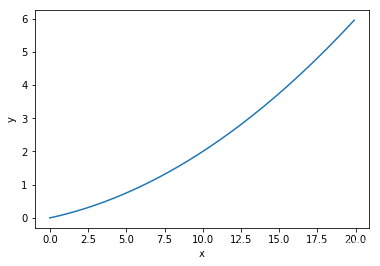import numpy as np
import matplotlib.pylab as plt
# 均方误差的实现
def mean_squared_error(y, t):
return 0.5 * np.num((y - t) ** 2)
# 交叉熵误差
def cross_entropy_error(y, t):
delta = 1e-7
return -np.sum(t*np.log(y+delta))
# mini-batch版交叉熵误差的实现
def cross_entropy_error(y, t):
if y.ndim == 1:
t = t.reshape(1, t.size)
y = y.reshape(1, y.size)
batch_size = y.shape[0]
return -np.sum(t*np.log(y+1e-7)) / batch_size
# 中心差分
def numerical_diff(f, x):
h = 1e-4 #0.0001
return (f(x+h) - f(x-h)) / (2*h)
#数值微分的例子
def function_1(x):
return 0.01*x**2 + 0.1*x
x = np.arange(0.0, 20.0, 0.1) # 以0.1为单位,从0到20的数组x
y = function_1(x)
plt.xlabel("x")
plt.ylabel("y")
plt.plot(x, y)
plt.show()

print(numerical_diff(function_1, 5))
print(numerical_diff(function_1, 10))
0.1999999999990898
0.2999999999986347
# 画在函数某一点的切线
def tangent_line(f, x):
d = numerical_diff(f, x)
print(d)
y = f(x) - d*x # 在这里y是截距,d是斜率
return lambda t: d*t + y
x = np.arange(0.0, 20.0, 0.1) # 以0.1为单位,从0到20的数组x
y = function_1(x)
plt.xlabel("x")
plt.ylabel("f(x)")
tf = tangent_line(function_1, 5)
y2 = tf(x)
plt.plot(x, y)
plt.plot(x, y2)
plt.show()
0.1999999999990898

np.array([3.0, 4.0])
array([3., 4.])
# 偏导数示例函数: 两个数的平方和
def function_2(x):
# 下一条更好
# return np.sum(x**2)
return x[0]**2 + x[1]**2
def numerical_gradient(f, x):
h = 1e-4 # 0.0001
grad = np.zeros_like(x) # 生成和x形状相同的数组
for idx in range(x.size):
tmp_val = x[idx]
# f(x+h)的计算
x[idx] = tmp_val + h
fxh1 = f(x)
# f(x-h)的计算
x[idx] = tmp_val - h
fxh2 = f(x)
grad[idx] = (fxh1 - fxh2) / (2*h)
x[idx] = tmp_val
return grad
numerical_gradient(function_2, np.array([3.0, 4.0]))
array([6., 8.])
# 梯度下降法
def gradient_descent(f, init_x, lr=0.01, step_num=100):
x = init_x
for i in range(step_num):
grad = numerical_gradient(f,x)
x -= lr * grad
return x
Use el método de gradiente para encontrar f (x 0 + x 1) = x 0 2 + x 1 2 f (x_0 + x_1) = (x_0) ^ 2 + (x_1) ^ 2f ( x0+X1)=X02+X12
def function_2(x):
return x[0]**2 + x[1]**2
init_x = np.array([-3.0, 4.0])
gradient_descent(function_2, init_x=init_x, lr=0.1, step_num=100)
array([-6.11110793e-10, 8.14814391e-10])
# 神经网络的梯度
import sys,os
import numpy as np
from common.functions import softmax, cross_entropy_error
from common.gradient import numerical_gradient
class simpleNet:
def __init__(self):
self.W = np.random.randn(2,3) # 用高斯分布进行初始化
def predict(self, x):
return np.dot(x, self.W)
def loss(self, x, t):
z = self.predict(x)
y = softmax(z)
loss = cross_entropy_error(y, t)
return loss
net = simpleNet()
print(net.W)
x = np.array([0.6, 0.9])
p = net.predict(x)
print(p)
print(np.argmax(p))
t = np.array([0, 0, 1])
net.loss(x,t)
[[-1.77081556 1.3171629 -0.88412637]
[ 1.73434721 -0.27546099 1.6995778 ]]
[0.49842315 0.54238284 0.9991442 ]
2
0.8062188854106839
def f(W):
return net.loss(x,t)
# f = lambda w: net.loss(x, t)
dW = numerical_gradient(f, net.W)
print(dW)
[[ 0.16238812 0.16968588 -0.332074 ]
[ 0.24358218 0.25452882 -0.498111 ]]
# 两层神经网络的类
import sys, os
from common.functions import *
from common.gradient import numerical_gradient
class TwoLayerNet:
def __init__(self, input_size, hidden_size, output_size,
weight_init_std=0.01):
# 初始化权重
self.params = {
}
self.params['W1'] = weight_init_std * \
np.random.randn(input_size, hidden_size)
self.params['b1'] = np.zeros(hidden_size)
self.params['W2'] = weight_init_std * \
np.random.randn(hidden_size, output_size)
self.params['b2'] = np.zeros(output_size)
def predict(self, x):
W1, W2 = self.params['W1'], self.params['W2']
b1, b2 = self.params['b1'], self.params['b2']
a1 = np.dot(x, W1) + b1
z1 = sigmoid(a1)
a2 = np.dot(z1, W2) + b2
y = softmax(a2)
return y
# x:输入数据, t:监督数据
def loss(self, x, t):
y = self.predict(x)
return cross_entropy_error(y, t)
def accuracy(self, x, t):
y = self.predict(x)
y = np.argmax(y, axis=1)
t = np.argmax(t, axis=1)
accuracy = np.sum(y == t) / float(x.shape[0])
return accuracy
def numerical_gradient(self, x, t):
loss_W = lambda W: self.loss(x, t)
grads = {
}
grads['W1'] = numerical_gradient(loss_W, self.params['W1'])
grads['b1'] = numerical_gradient(loss_W, self.params['b1'])
grads['W2'] = numerical_gradient(loss_W, self.params['W2'])
grads['b2'] = numerical_gradient(loss_W, self.params['b2'])
return grads
def gradient(self, x, t):
W1, W2 = self.params['W1'], self.params['W2']
b1, b2 = self.params['b1'], self.params['b2']
grads = {
}
batch_num = x.shape[0]
#forward
a1 = np.dot(x, W1) + b1
z1 = sigmoid(a1)
a2 = np.dot(z1, W2) + b2
y = softmax(a2)
#backward
dy = (y-t)/batch_num
grads['W2'] = np.dot(z1.T, dy)
grads['b2'] = np.sum(dy, axis=0)
da1 = np.dot(dy, W2.T)
dz1 = sigmoid_grad(a1) * da1
grads['W1'] = np.dot(x.T, dz1)
grads['b1'] = np.sum(dz1, axis = 0)
return grads
# mini-batch的实现
import numpy as np
from mnist import load_mnist
(x_train, t_train), (x_test, t_test) = load_mnist(normalize=True, one_hot_label = True)
train_loss_list = []
train_acc_list = []
test_acc_list = []
iter_per_epoch = max(train_size / batch_size, 1)
iters_num = 10000
train_size = x_train.shape[0]
batch_size = 100
learning_rate = 0.1
network = TwoLayerNet(input_size=784, hidden_size=50, output_size=10)
for i in range(iters_num):
# 获取mini-batch
batch_mask = np.random.choice(train_size, batch_size)
x_batch = x_train[batch_mask]
t_batch = t_train[batch_mask]
# 计算梯度
#grad = network.numerical_gradient(x_batch, t_batch)
grad = network.gradient(x_batch, t_batch)
for key in ('W1', 'b1', 'W2', 'b2'):
network.params[key] -= learning_rate * grad[key]
# 记录学习过程
loss = network.loss(x_batch, t_batch)
train_loss_list.append(loss)
# 计算每个epoch的识别精度
if i % iter_per_epoch == 0:
train_acc = network.accuracy(x_train, t_train)
test_acc = network.accuracy(x_test, t_test)
train_acc_list.append(train_acc)
test_acc_list.append(test_acc)
print("train acc, test acc | " + str(train_acc) + ", " + str(test_acc))
train acc, test acc | 0.09915, 0.1009
train acc, test acc | 0.7893833333333333, 0.7955
train acc, test acc | 0.8799333333333333, 0.8822
train acc, test acc | 0.8994666666666666, 0.9022
train acc, test acc | 0.9077833333333334, 0.9106
train acc, test acc | 0.9147666666666666, 0.917
train acc, test acc | 0.9200666666666667, 0.9212
train acc, test acc | 0.9235333333333333, 0.9257
train acc, test acc | 0.9283166666666667, 0.93
train acc, test acc | 0.9314833333333333, 0.9308
train acc, test acc | 0.93475, 0.9346
train acc, test acc | 0.9373333333333334, 0.9371
train acc, test acc | 0.9395666666666667, 0.939
train acc, test acc | 0.9419166666666666, 0.9406
train acc, test acc | 0.9436666666666667, 0.943
train acc, test acc | 0.9460166666666666, 0.9445
train acc, test acc | 0.9468833333333333, 0.9473
markers = {
'train': 'o', 'test':'s'}
x = np.arange(len(train_acc_list))
plt.plot(x, train_acc_list, label='train acc')
plt.plot(x, test_acc_list, label='test acc', linestyle='--')
plt.xlabel("epochs")
plt.ylabel("accuracy")
plt.ylim(0, 1.0)
plt.legend(loc='lower right')
plt.show()
